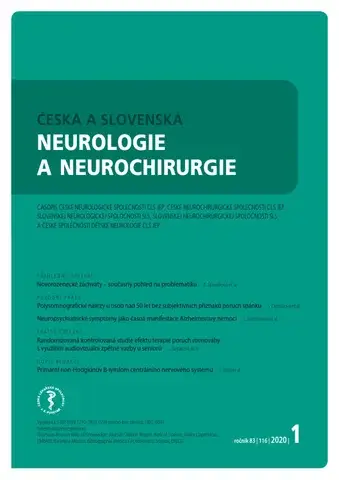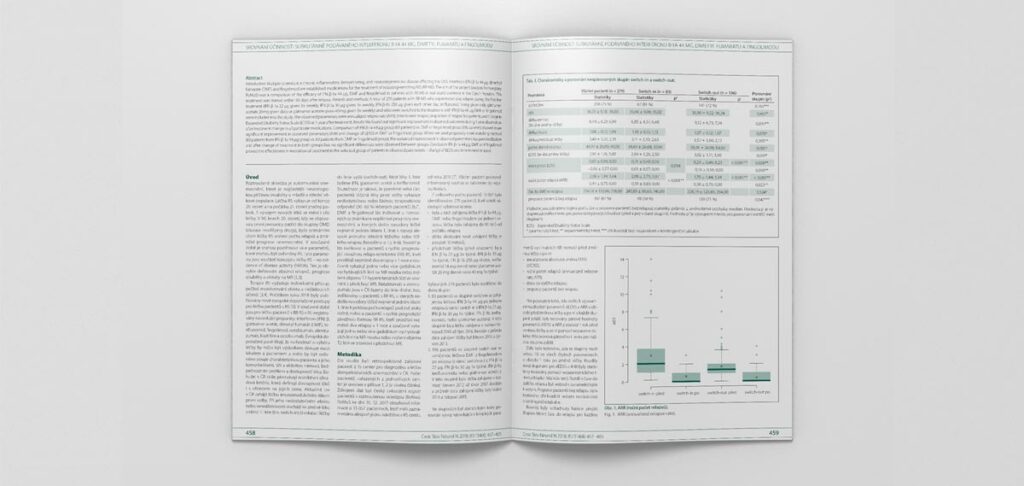Multiple sclerosis (MS) is a chronic inflammatory demyelinating and neurodegenerative disease affecting the central nervous system. Interferon (IFN) β-1a 44 μg, dimethyl fumarate (DMF), and fingolimod are established medications for the treatment of relapsing-remitting MS (RR MS). The aim of this project, which includes an analysis of data from the ReMuS registry, was to compare the efficacy of IFN β-1a 44 μg, DMF, and fingolimod in patients with RR MS in real-world clinical practice in the Czech Republic.

Pavelek, Z., Sobíšek, L., & Vališ, M. (2017). A comparison of efficacy of subcutaneous interferon β-1a 44 μg, dimethyl fumarate and fingolimod in the real-life clinical practice - a multicenter observational study. In Czech and Slovak Neurology and Neurosurgery (Vol. 81/114, Issue 4, pp. 457-465). Care Comm. https://doi.org/10.14735/amcsnn2018457
Abstract
Background: Multiple sclerosis is a chronic inflammatory demyelinating and neurodegenerative disease affecting the CNS. Interferon (IFN) β-1a 44 μg, dimethyl fumarate (DMF) and fingolimod are established medications for the treatment of relapsing-remitting MS (RR MS). The aim of the project (analysis from registry ReMuS) was a comparison of the efficacy of IFN β-1a 44 μg, DMF and fingolimod in patients with RR MS in real world evidence in the Czech Republic. This treatment was started within 90 days after relapse.
Dataset and methods: A total of 279 patients with RR MS who experienced one relapse during the first line treatment (IFN β-1a 22 μg given 3× weekly, IFN β-1a 30 μg given 1× weekly, IFN β-1b 250 μg given each other day, teriflunomid 14 mg given daily, glatiramer acetate 20mg given daily or glatiramer acetate given 40mg given 3× weekly) and who were switched to the treatment with IFN β-1a 44 μg, DMF or fingolimod were included into the study. The observed parameters were annualized relapse rate (ARR), time to next relapse, proportion of relapse free patients and change in Expanded Disability Status Scale (EDSS) at 1-year after treatment.
Results: We found out significant improvement in observed outcomes during 1-year observation after treatment change in all particular medications. Comparison of IFN β-1a 44 μg group (83 patients) vs. DMF or fingolimod group (196 patients) showed more significant improvement in observed parameters (ARR and change of EDSS) in DMF or fingolimod group. When we used propensity score matching method (83 patients from IFN β-1a 44 μg group vs. 83 patients from DMF or fingolimod group), the sustained improvement in observed parameters has persisted before and after change of treatment in both groups but no significant differences were observed between groups.
Conclusion: IFN β-1a 44 μg, DMF and fingolimod proved the effectivness in escalation of treatment in the selected group of patients in observed parameters – change of EDSS and time to next relapse).
The full article is available in Czech after logging in on the website of the journal Czech and Slovak Neurology and Neurosurgery.

